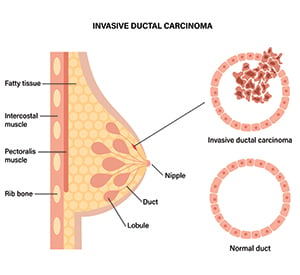Invasive Ductal Carcinoma Stages

Invasive ductal carcinoma stages provide physicians with a uniform way to describe how far a patient’s cancer may have spread beyond its original location in a milk duct. This information can be helpful when evaluating treatment options, but it is not a definite sign in and of itself. Many factors can influence a patient’s outcome, so the best source of information for understanding a breast cancer prognosis is always a physician who is familiar with the patient’s case.
What is invasive ductal carcinoma?
Invasive ductal carcinoma (also referred to as infiltrating ductal carcinoma) is the most common type of breast cancer, accounting for approximately 80% of the total number of cases. Invasive ductal carcinoma occurs when cancerous cells form in a duct that carries milk from a lobule (a gland in the breast that produces milk) to the nipple, and then spreads to tissue outside the duct.

How fast does invasive ductal carcinoma spread?
In many cases, after someone is diagnosed with invasive ductal carcinoma or any other type of cancer, one of their first questions is how quickly they can expect the malignancy to grow and spread. Unfortunately, it’s difficult to answer this question, since the rate at which invasive ductal carcinoma progresses will vary from one patient to another.
There are numerous different factors that can influence how fast breast cancer will grow and spread (metastasize) to distant areas of the body. For example, triple-negative invasive ductal carcinomas tend to grow and spread more quickly than certain other types of breast cancer. Age can also impact growth rates—generally speaking, younger patients tend to have breast cancers that are more aggressive and fast-growing than the ones affecting older patients.
After diagnosing a patient with invasive ductal carcinoma, an experienced medical provider will be able to supply them with a more accurate estimate of how quickly their malignancy will grow and spread. The provider will also be able to advise the patient on what they can do (if anything) to slow down the cancer’s growth rate.
What are the stages of invasive ductal carcinoma?
Invasive ductal carcinoma is usually described through a numeric scale ranging from 1 (the earliest stage) to 4 (the most advanced stage). Specifically, the invasive ductal carcinoma stages are:
Stage 1 invasive ductal carcinoma
When a breast tumor is smaller than 2 centimeters in diameter and the cancer has not spread beyond the breast, it will be classified as stage 1.
Stage 2 invasive ductal carcinoma
By stage 2, a breast tumor measures 2 to 4 centimeters in diameter or cancerous cells have spread to the lymph nodes in the underarm area.
Stage 3 invasive ductal carcinoma
Once a tumor is classified as stage 3, more extensive cancer is found, but it is confined to the breast, surrounding tissues and lymph nodes.
Stage 4 invasive ductal carcinoma
When the breast cancer has metastasized to lymph nodes beyond the underarm area or to distant sites—such as the lungs, liver, bones or brain—it will be classified as stage 4. Once the cancer reaches this stage, it will also be known as “metastatic invasive ductal carcinoma.”
What is the survival rate for invasive ductal carcinoma?
The invasive ductal carcinoma survival rate varies depending on the stage the patient is at. For example, the national average survival rates are as follows:
- If invasive ductal carcinoma has not spread beyond the breast, the five-year survival rate is approximately 99%.
- If the cancer has spread to nearby structures or lymph nodes, the five-year survival rate is approximately 86%.
- If the cancer has spread to a distant area of the body, the five-year survival rate is approximately 27%.
When considering these numbers, it’s important to remember that they are just general benchmarks and should not be used to predict a specific person’s chances of survival. In addition, Moffitt’s breast cancer survival rates exceed 1.5 times the national average.
Invasive ductal carcinoma treatment at Moffitt
In the Don & Erika Wallace Comprehensive Breast Program at Moffitt Cancer Center, our multispecialty tumor board reviews breast cancer cases during a weekly meeting, meaning our patients receive highly individualized treatment based on multiple expert opinions. We also offer comprehensive screening, diagnostic and supportive care services without the need for referrals.
If you’d like to learn more about invasive ductal carcinoma stages and treatment options, call 1-888-663-3488 or complete a new patient registration form online. At Moffitt, we provide every new patient with rapid access to a cancer expert as soon as possible, a turnaround faster than that offered by any other cancer hospital in the country.
References
Diagnosis
